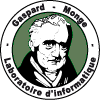The fields of analysis, processing and synthesis of images have experienced, for several decades, a great development as well from the point of view of their applications as from the point of view of the methods used. In this very vast scientific field, the a3si group develop nine research topics which are the following:
> Architectures dedicated to imagery. Our approach to this study is of the type algorithm-architecture adequacy. This one consists in simultaneously studying the algorithmic and architectural aspects by taking into account the constraints (in terms of resources, response time) while aiming at optimizing the implementation and reducing development time.
> Computer graphics and 3D modeling. Data processing in general and graphic data processing in particular play a big role in the realization of virtual prototypes. The use of virtual tools, and especially visual ones makes it possible to interpret an important quantity of information quickly. Nevertheless, the complexity of the models implemented to obtain a realistic image is still an obstacle for the standard user who seeks a fast tool helping him in his work. In this context, our work concerns more particularly the simulation of the illumination of a scene, the simulation of the participating mediums and the simulation of the light/matter interactions, with applications to virtual reality and augmented reality.
> Discrete geometry and computational geometry. Discrete geometry and computational geometry are two new branches of mathematics appeared recently under the impulse of the development of computer science. They take part of the theoretical study of the models of spatial objects which can be handled by computers, as well as transformations that can be applied to these models.
> Discrete topology. We study fundamental topological concepts, such as the one of continuous deformation, within the framework of discrete spaces. This study leads us to propose new operators applying to spatial data, images or geometrical models, which preserve topology or modify it in a controlled way.
> Global optimization, image filtering and analysis. The main objective of this topic is to develop new image segmentation methods by a series of approaches based on minimization of global, rather than local, performance indexes.
> Image processing and applications. We are interested in various aspects of image processing, in particular those related to the digital representation of color, and to the retrieval of images in databases. We are involved in several collaborative projects in various applicative fields, in which image processing plays an important role.
> Machine learning. Machine learning is a discipline at the intersection between statistics, computer science and applied mathematics. It aims to generate theories and general techniques for dealing with complex systems for which there is no model that is simple, accurate and easy to implement.
The development of sensors for data acquisition, increased capacity of storage and computing power of computers offer new perspectives to understand and model complex systems from observations.
This automatic learning is used to perform tasks in computer vision that are intractable by conventional methods (detection of objects, recognition of handwriting, segmentation, indexing, image mining).
> Mathematical morphology. Mathematical morphology is a discipline created 40 years ago per Georges Matheron and Jean Serra, which establishes a theoretical framework for the study of a broad class of non-linear operators acting on images or more generally on multidimensional signals. We contribute to the evolution and the enrichment of this field, both on theoretical and algorithmic aspects, as well as by developing various applications.
> Three-dimensional reconstruction from images. Three-dimensional reconstruction from simple photographs may be obtained thanks to the principle of stereovision. It consists of finding, in various digital images of a scene taken from different viewpoints, the pixels corresponding to the same point of the real scene.
We have developed new approaches to obtain a complete three-dimensional reconstruction of an object from a series of images taken around the object. Rather than tackling the ambiguous matching problem, we aim at finding a shape which, globally, realizes the best possible fit with the measures, while satisfying a priori constraints on the scene (as the regularity of the objects surfaces).
This approach leads naturally to a formulation called variational, that is to say, finding a minimum energy configuration for an energy functional to be defined. It is based on the tools of mathematical optimization, as well as those of differential geometry.

